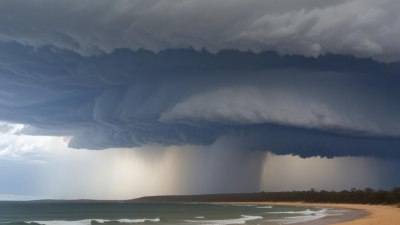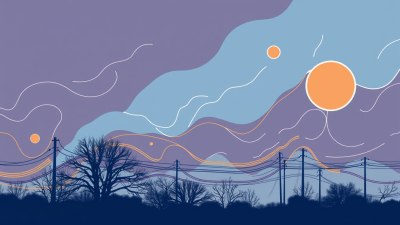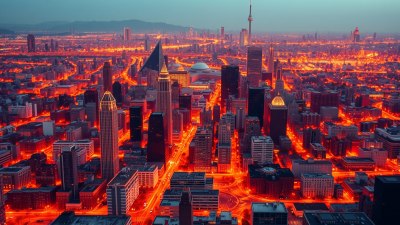Why Your Commute Feels Different in Winter vs. Summer
Explore the seasonal changes impacting your commute experiences in winter and summer.

Image by surfacepatterns on Freepik
Your daily commute, a routine for many, can feel remarkably different depending on the season. While the destination remains the same, the journey can take on a new dimension as the weather changes. Understanding these differences can enhance your commuting experience and help you better prepare for the conditions.
Temperature Changes
One of the most obvious differences between winter and summer commutes is the temperature. In winter, chilly air often greets commuters, prompting the need for warmer clothing and potentially affecting the mood. Cold temperatures can lead to discomfort, which often makes the commute feel longer and less enjoyable. In contrast, summer commutes are often characterized by warmer weather, which typically brings a different energy. The warmth of the sun can uplift spirits, making the journey feel shorter and more pleasant.
Impact of Weather
Severe weather conditions during winter, such as snow, ice, and heavy rain, can have a major impact on commuting times and methods. Snow-covered roads can lead to traffic delays, and icy sidewalks may result in treacherous walking conditions. Commuters might also face longer times waiting for public transportation due to delays caused by inclement weather. Conversely, summer weather is usually more predictable and stable, often resulting in smoother commutes. Light rain can be refreshing, but excessive heat can also lead to increased traffic as drivers seek out air-conditioned routes or their air-conditioned vehicles.
Daylight Hours
The amount of daylight also has a significant impact on how commuting feels in different seasons. In winter, shorter days mean that many commuters find themselves traveling to and from work in the dark. This can lead to feelings of isolation and disconnection from the outside environment. The lack of natural light can make commutes feel dreary and monotonous. In contrast, summer commutes offer longer daylight hours, encouraging people to engage more with their surroundings while commuting. The bright evenings provide a sense of freedom and relaxation, which can improve overall mood and make the journey feel less burdensome.
Commute Timing
The timing of commutes can also shift with the seasons. Many people in colder regions tend to leave earlier in the winter to avoid the worst of the morning frost and potential delays caused by snow removal. In contrast, summer months often see people leaving later, lured by pleasant mornings that encourage outdoor enjoyment. School schedules can also affect commute times, as families with children adjust their timelines for school vacations in the summer.
Public Transportation Changes
For those who rely on public transportation, the season can also lead to different experiences. In winter, commuters may find trains and buses crowded with people seeking warmth and shelter. On the other hand, summer often offers a more comfortable ride due to lower usage as some people take vacations or work from home. However, summer can also see an influx of tourists using public transport, which can lead to crowded conditions, particularly in urban areas.
Psychological Impacts
The psychological effects of commuting in different seasons cannot be overlooked. Winter commutes can be psychologically taxing, often leading to stress and anxiety, especially when faced with weather-related delays. This can create a negative feedback loop, making the commute feel longer and more burdensome. In contrast, the summer season tends to boost morale. People may be more relaxed and happier during the warmer months, allowing them to enjoy their commute more and approach it with a positive mindset. This shift in mood can make a significant difference in perceived travel time.
Mode of Transportation
Different seasons also affect the modes of transportation people choose for their commutes. In the winter, individuals may prefer to drive to work rather than walk or bike due to the cold and possible snow, leading to increased vehicular traffic. In summer, a significant number of people opt for cycling, walking, or even leisurely driving with the windows down, taking advantage of the pleasant weather. This shift creates a more vibrant and diverse commuting atmosphere in the summertime.
Clothing Choices
The clothes we wear significantly affect our overall experience during our commute. In winter, heavy layers, boots, and outerwear can restrict movement and lead to discomfort. This can impact both mood and mobility while commuting. In contrast, summer clothing tends to be lighter and more breathable, allowing for greater comfort. The ease of warm weather attire can lead to a more pleasant journey, whether it's a walk to work or a bus ride.
Health Considerations
Health is another important factor influenced by seasonality. Winter often brings an increased risk of illness, with people catching colds or flu during the colder months. This can make commutes more uncomfortable and can affect overall productivity. Additionally, the cold weather may discourage outdoor exercise, leading to decreased physical activity during the winter months. In contrast, summer encourages outdoor activities, leading to increased physical fitness and better overall health, providing a boost to those commuting during warmer times.
Community Dynamics
Seasonal changes can also influence community dynamics along commuter routes. In winter, community interactions may diminish as people retreat indoors, reducing the number of social encounters during commutes. In the summer, communities often come alive, with outdoor festivals, street fairs, and other events. These interactions can create a sense of connection among commuters and enhance the commuting experience.
Seasonal Affective Disorder
For some individuals, the difference in commute feelings between winter and summer can relate to broader issues such as Seasonal Affective Disorder (SAD). This condition affects many people during the darker months of winter, leading to lethargy and depressive feelings that can extend even to the commute itself. Summer’s increased daylight hours and warmer temperatures can alleviate some of these effects, highlighting how important seasonal changes are in shaping our daily experiences.
As the seasons change, so too does our experience of commuting. By understanding the various factors that contribute to these changes, from temperature to psychological impacts and community dynamics, commuters can better prepare and adapt to their travels. Embracing the unique aspects of each season can transform daily commutes into anticipated experiences rather than just a part of the routine. Whether it’s the chill of winter or the warmth of summer, each season brings its own flavor to the journey, inviting us to engage differently with the world around us.











